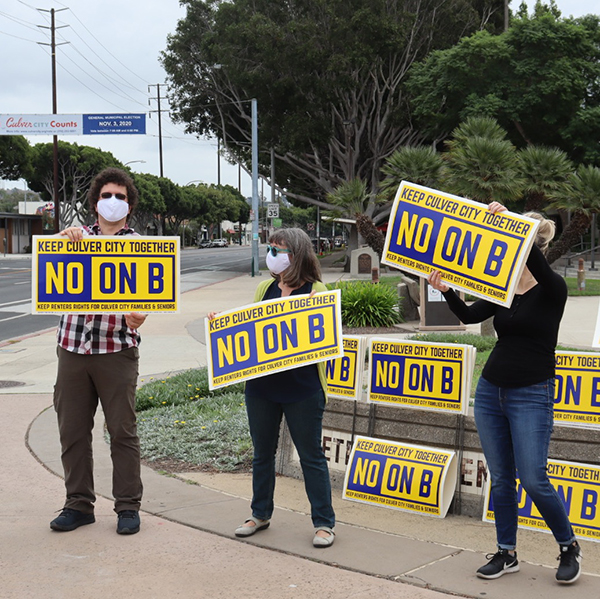By Cynthia Gibson
Contributing Writer
CULVER CITY — A ballot measure on the Nov. 3 ballot could undo a recent permanent rent control ordinance passed by the City Council.
Members of the City Council, renters and landlord groups are fighting over Measure B, which would repeal rent control measures passed after Jan. 1, 2019, including Culver City’s newly implemented rent control ordinance. It would also eliminate the City Council’s authority to implement similar measures in the future. Voters would be the only ones who could institute rent control through the ballot box.
Culver City adopted a permanent rent control ordinance Sept. 29, which would limit increases to 2.25% for the rest of the year.
If Measure B passes, the city would once again be governed by the state’s rent control law, which allows 5% plus the consumer price index in annual rent increases in cities not covered under an ordinance. Measure B, however, does not affect expanded tenant protections that were adopted by City Council during the same meeting.
Measure B was initiated by a group called Protect Culver City, a political action committee primarily composed of residential landlords and business owners who penned the legislation in opposition to the City Council deciding to phase in rent control last year.
The group argued that rent control was pushed through with little public input and that Measure B would allow voters to make decisions on critical issues like this.
“If the City Council wants to raise your taxes, they have to put it up for a vote [in many cases]. We want rent control treated in that same way,” Protect Culver City President Ron Bassilian said.
Opponents of Measure B, however, say the measure makes it more difficult for the city to implement rent control policies, amounting to a false choice.
“A yes vote on Measure B, doesn’t mean rent control. It means no rent control,” said City Councilwoman Meghan Sahli-Wells at an Oct. 24 event at Veterans Memorial Park where Measure B opponents handed out lawn signs. “So it’s not like ‘let the voters decide,’ because there is no possibility to support rent control if you were voting yes.”
Sahli-Wells added that Measure B actually puts up barriers to rent control by making voters take up the onerous process of getting a rent control measure on the ballot and then persuading people to vote for it.
There were also allegations from some residents that Measure B vote canvassers were intentionally misleading voters about what it does, saying that their signatures would mean approving rent control.
Protect Culver City’s website called Culver City’s rent control ordinance “potentially disastrous” and claimed the ordinance is punitive towards Mom-and-Pop landlords and will drive them out of the rental market. The group pointed out that California already has statewide rent control, AB 1482, which went into effect Jan. 1, and that administering local rent control would be costly to the city.
“This council is creating a seven-figure bureaucracy to duplicate a service that already exists through the state,” said Culver City landlord Katherine McKinney during the Sept. 29 City Council meeting. McKinney also expressed support for Measure B during her public comment and claimed that rent control may be an incentive for smaller landlords to sell their rental units to large corporations who will build luxury housing and charge higher rents.
Sahli-Wells countered, however, that AB 1482’s protections aren’t strong enough. Under state law, landlords can raise rents up to 10%, a significant burden for many renters, while under the Culver City ordinance, they can only raise rents up to 5%. The California rent control statute states if the consumer price index exceeds an annual rate of 10%, rental increases cannot increase more than 10%.
Katy Krantz, who distributed lawn signs with other Measure B opponents Oct. 24, said the ballot measure undermined the will of the people.
“The voters voted in the City Council and they did their job,” she said. “They created ordinances. They legislated. That’s how democracy works.
“I don’t really think it’s fair to then come in with a ballot measure to take away the ordinance that they created.”
Bassilian said the Protect Culver City was formed partly because none City Council members ran on a pro-rent control platform, giving PAC members the impression that rent control was off the table.
“They did a complete 180,” he said. “We thought they were economic centrists. A lot of people felt like they got a council they never agreed on and we suspected that we’d be seeing other issues like this coming down the pipe.”













